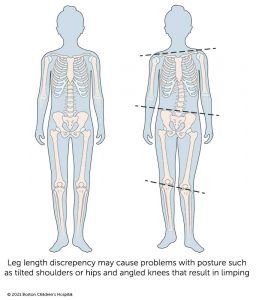If you are like most car owners, you want to make sure your car goes in for regular servicing, because you understand that without maintenance it’s only a matter of time before your car is likely to break down. The same thing applies to us and our bodies; we know for sure that without regular exercise and check-ups we are less likely to have a smooth journey through life.
One of the most important, but often overlooked, health checks are a simple leg-length comparison test. Most of us are able to use our own two legs for transport and support every day of our lives. But these two vitally important support and transportation systems are also able to divulge secrets about our body’s health. Helping us decide whether we are on course for a ‘roadside breakdown’, or indeed even revealing the cause of existing health problems.
What is the legs-length discrepancy?
A legs-length discrepancy means when one leg is shorter than the other leg. This difference may be an inch or several inches. Some children are born with this problem and some children have this problem after born. But most of the people do not notice this. But it is most important in future life.
Signs of leg-length discrepancy:
There are several reasons for the leg-length discrepancy. And by following these signs you can identify that someone has a leg-length discrepancy problem.
1. Most common sign is problems with body posture, like – some having a tilting shoulder.
2. Someone has walking problems. If you notice someone walking with dragging, then that person may be suffering leg-length discrepancy.
3. If anyone feels knee joint pain regularly without any reason.
4. If anyone feels waist joint pain without any reason when he/she walks.
Reason for the legs-length discrepancy:
The reason is easy to see and understand with a little imagination. On top of our legs sits the hip or pelvis, which is the foundation for our spinal column supporting our whole upper body. The spinal column is made up of many moveable vertebrae down through which traverse our spinal cord. Through openings in the vertebrae, the spinal cord is able to sprout literally millions of nerve fibers. Which route their way to connecting organs and other parts of our body, signaling important information to and from the brain back and forth to these body parts.

If these important nerves become irritated or impaired, then those body parts which are attached to these nerve endings are also very likely to suffer in some way.
In fact not only back pain, but all manner of health issues may arise as organs and body functions are unable to operate properly or efficiently. Health problems associated with such spinal connections may include all manner of common ailments from gallbladder problems and liver disruption to digestive problems, headaches, migraine, allergies, and more.
So what might be the underlying cause of this spinal nerve irritation or entrapment?
Our spinal column is seated on the pelvis. So as long as the pelvis is able to provide a structurally sound foundation the spine will of course be able to sit upright and straight.
However, if the pelvis is twisted in some way, the spinal column cannot sit on a horizontal foundation and will be forced into misalignment with muscles pulling vertebrae out of place. Potentially causing these vertebrae to trap or pinch spinal nerves. The cause of any pelvic tilt or twisting itself can be put down to, amongst other things, badly seated leg joints caused by prolonged poor body posture.
1. Carrying out a simple leg-length comparison check takes only a minute. But requires two people, one to perform the check on the patient who is lying down. Simply lifting both legs up to eye level and noting the relative position of the heals should show up any leg length discrepancy. And therefore reveal whether the pelvis is likely to be sitting horizontally Or twisted in some way.
2. During a Dom Method treatment, the pelvis is then checked as confirmation and any corrections are then made. However, there are simple exercises that can be performed each day to help to keep the legs firmly seated in the hip, and which also help to balance the body.
3. Simply place your hand underneath your buttock and pull upwards. Whilst lifting your knee up and down for a few moves will do an amazing job of keeping your pelvis sitting horizontal and therefore your spinal column upright and straight. Repeat for each leg several times a day.
CHW @ By Brigitte Nath
nethun
I am Md. Shahriar Pervez. I am a professional blogger and Youtuber. I complete my graduate from AIUB. Please visit this blog to get more information. SUBSCRIBE to this website and stay with us.




